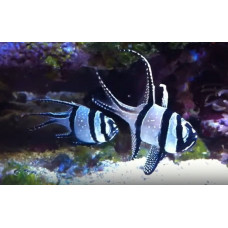Latin name
Pterapogon kauderni
Other name
Pterapogon kauderni
Identification
The Banggai cardinalfish has an oval, large body with long, elongated fins. There is no sexual dimorphism.
Features of fish fins
The first dorsal fin has 8 hard rays, the second has 14 soft rays. The anal fin begins with two hard rays and is supported by 13 soft rays.
Fish colouring
The body of the Banggai cardinalfish is silvery, white and grey. Two large black horizontal stripes run down the body. The first begins at the base of the dorsal fin and ends at the ventral fin. The second begins at the base of the second very long dorsal fin and ends at the anal fin. The head has a transverse stripe across the large eyes. The forked tail has two black longitudinal bars. All fins, the sides between the transverse stripes, and the base of the tail have a pattern of white spots that is unique to each individual.
Distribution
BandungThe species lives in a small area around the islands of Banggai, Bandang, Kembangan, South Peleng and other small islands. Its total range is 5,500 km2. As the fish only live in sheltered, isolated bays on the sheltered side of 30 islands, the actual range is 34 km2.
Habitat
This is a tropical marine bottom species. The depth ranges from 0 to 16 m. They live in shallow waters in thickets of Enhalus acoroides, in mangroves, lagoons and coral reefs. They even inhabit the mouths of freshwater creeks and the polluted waters of harbours. They prefer depths from half a metre to 4.5 metres. The water in their natural habitat is very warm, from 28 to 31°C.
Size
The body length of this species is 8 cm.
Behavior
Banggai cardinalfish live in groups of up to 500 individuals, the majority of which are juveniles up to six months old. Juveniles, 1 to 1.5 cm long, are sheltered in groups of 2 to 12 individuals between the needles of the sea urchin Diadema setosum, the tentacles of the coral Heliofungia actiniformis, anemones of the genus Stichodactyla or Entacmaea quadricolor. Adults can also find shelter ingrowing branching rock corals such as Acropora, Montipora digitata, Seriatopora hystrix or fire corals (Millepora sp). The fish share their habitat with other members of the family, reef fish, sea needles and clownfish such as Amphiprion clarkii, Amphiprion perideraion and Amphiprion ocellaris.
Food and feeding habits
The large eyes of these fish indicate that they are active at dusk. They feed on a variety of zooplankton, mainly ostracod crustaceans, small decapod crustaceans, woodlice, and eggs and larvae of various marine animals.
Reproduction
The female begins to interpret. She keeps circling under the male's tail and this can go on hundreds of times for several hours. As the males carry eggs in their mouths, they have to be "persuaded" to spawn. The spawning process itself takes several seconds. Once the caviar has been transferred, there is another long display that often lasts 30 to 40 minutes, but can last almost an hour. Both partners circle each other. It is only then that the insemination of the eggs may take place.
The caviar consists of only 5-25 orange-coloured eggs, about 2.5 mm in size. Males carrying eggs in their mouths do not eat during this period. The fry do not have a larval stage and hatch from the egg about 25 days after the final metamorphosis. Newly hatched larvae do not have a planktonic period. Once the larvae emerge, they are no longer cared for by the adult fish.
Fishing
Banggai cardinalfish is not commercially important in fisheries.
Relationship with a person
Harmless. They are commonly found in the aquarium trade. This species can be bred in captivity.
| Classification | |
| Phylum | Chordata |
| Class | Actinopterygii |
| Squad | Gobiiformes |
| Family | Apogonidae |
| Genus | Pterapogon |
| Species | P. kauderni |
| Features | |
| Conservation status | Endangered |
| Habitat | Bottom |
| Life span, years | No information |
| Maximum body weight, kg | No information |
| Maximum length, cm | 8 |
| Sailing speed, m/s | No information |
| Threat to people | Not edible |
| Way of eating | Planktonophage |
Banggai cardinalfish
Tags: banggai cardinalfish



